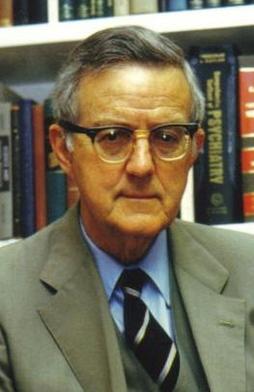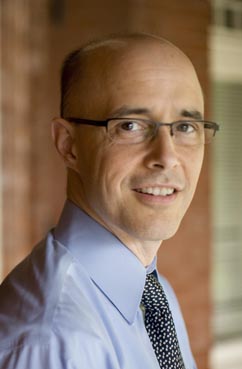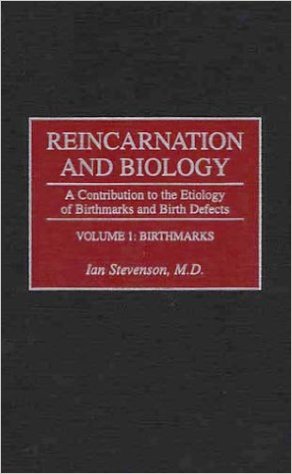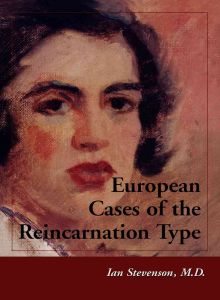
Parapsychology is the study of alleged psychic phenomena and other paranormal claims, for example, those related to near-death experiences, synchronicity, apparitional experiences, etc. Criticized as being a pseudoscience, the majority of mainstream scientists reject it. Parapsychology has also been criticised by mainstream critics for claims by many of its practitioners that their studies are plausible despite a lack of convincing evidence after more than a century of research for the existence of any psychic phenomena.
Parapsychology is a field of research that studies a number of ostensible paranormal phenomena, including telepathy, precognition, clairvoyance, psychokinesis, near-death experiences, reincarnation, and apparitional experiences.

Reincarnation, also known as rebirth or transmigration, is the philosophical or religious concept that the non-physical essence of a living being begins a new life in a different physical form or body after biological death. In most beliefs involving reincarnation, the soul of a human being is immortal and does not disperse after the physical body has perished. Upon death, the soul merely becomes transmigrated into a newborn baby or an animal to continue its immortality. The term transmigration means the passing of a soul from one body to another after death.

Ian Pretyman Stevenson was a Canadian-born American psychiatrist, the founder and director of the Division of Perceptual Studies at the University of Virginia School of Medicine.

Xenoglossy, also written xenoglossia and sometimes also known as xenolalia, is the supposedly paranormal phenomenon in which a person is allegedly able to speak, write or understand a foreign language that they could not have acquired by natural means. The term derives from the Ancient Greek xenos (ξένος), "foreigner" and glōssa (γλῶσσα), "tongue" or "language". The term xenoglossy was first used by French parapsychologist Charles Richet in 1905. Claims of xenoglossy are found in the New Testament, and contemporary claims have been made by parapsychologists and reincarnation researchers such as Ian Stevenson. Doubts have been expressed that xenoglossy is an actual phenomenon, and there is no scientifically admissible evidence supporting any of the alleged instances of xenoglossy.
Near-death studies is a field of psychology and psychiatry that studies the physiology, phenomenology and after-effects of the near-death experience (NDE). The field was originally associated with a distinct group of North American researchers that followed up on the initial work of Raymond Moody, and who later established the International Association for Near-Death Studies (IANDS) and the Journal of Near-Death Studies. Since then the field has expanded, and now includes contributions from a wide range of researchers and commentators worldwide. Research on near-death experiences is mainly limited to the disciplines of medicine, psychology and psychiatry.
Past life regression, Past life therapy (PLT), regression or memory regression is a method that uses hypnosis to recover what practitioners believe are memories of past lives or incarnations. The practice is widely considered discredited and unscientific by medical practitioners, and experts generally regard claims of recovered memories of past lives as fantasies or delusions or a type of confabulation. Past-life regression is typically undertaken either in pursuit of a spiritual experience, or in a psychotherapeutic setting. Most advocates loosely adhere to beliefs about reincarnation, though religious traditions that incorporate reincarnation generally do not include the idea of repressed memories of past lives.
Erlendur Haraldsson was a professor emeritus of psychology on the faculty of social science at the University of Iceland. He published in various psychology and psychiatry journals. In addition, he published parapsychology books and authored a number of papers for parapsychology journals.

Acharya Godwin Samararatne was one of the best known lay meditation teachers in Sri Lanka in recent times. During his teaching career he was based at his Meditation Centre at Nilambe in the central hill country near Kandy. After his death in March 2000 letters and tributes poured in as many people around the world attested to the impact that Godwin and his teaching had made on their lives.

Life Before Life: A Scientific Investigation of Children's Memories of Previous Lives is a 2005 book written by psychiatrist Jim B. Tucker, which presents an overview of more than 40 years of reincarnation research at the University of Virginia, into children's reports of past-life memories. The book also discusses "birthmarks and birth defects that match those of a deceased person who is identified by the child". The foreword to the book is written by Ian Stevenson.

Jim B. Tucker is a child psychiatrist and Bonner-Lowry Professor of Psychiatry and Neurobehavioral Sciences at the University of Virginia School of Medicine. His main research interests are documenting stories of children who he claims remember previous lives, and natal and prenatal memories. He is the author of Life Before Life: A Scientific Investigation of Children’s Memories of Previous Lives, which presents an overview of over four decades of reincarnation research at the Division of Perceptual Studies. Tucker worked for several years on this research with Ian Stevenson before taking over upon Stevenson's retirement in 2002.
Satwant Pasricha is the head of Department of Clinical Psychology at NIMHANS, National Institute of Mental Health and Neurosciences at Bangalore. She also worked for a time at the University of Virginia School of Medicine in the USA. Pasricha investigates reincarnation and near-death experiences. Pasricha co-authored the 2011 book Making sense of near-death experiences, which was Highly Commended in the Psychiatry category at the 2012 British Medical Association Book Awards.

Old Souls: The Scientific Search for Proof of Past Lives is a non-fiction book by journalist Tom Shroder. An editor at The Washington Post, Shroder traveled extensively with psychiatrist Ian Stevenson of the University of Virginia, who conducted past life and reincarnation research in Lebanon, India and the American South. Shroder's journalistic experience makes this book a valuable review of an often disparaged subject.

C. T. K. Chari was Head of the Department of Philosophy at Madras Christian College from 1958 to 1969 and the most prominent among contemporary Indian philosophers who paid close attention to psi phenomena. Chari published extensively on extremely diverse topics, such as logic, linguistics, information theory, mathematics, quantum physics, philosophy of mind, and, of course, psi research.
Carol Bowman M.S. is an author, lecturer, counselor, and therapist, known for her work in studying alleged cases of reincarnation, especially those involving young children.

Where Reincarnation and Biology Intersect is a 1997 book by psychiatrist Ian Stevenson, published by Praeger. The book is about birthmarks and birth defects ostensibly associated with reincarnation. Where Reincarnation and Biology Intersect is written for the general reader and is a condensation of a two-part monograph Reincarnation and Biology: A Contribution to the Etiology of Birthmarks and Birth Defects.

Reincarnation and Biology: A Contribution to the Etiology of Birthmarks and Birth Defects is a 1997 two-part monograph written by psychiatrist Ian Stevenson and published by Praeger. Where Reincarnation and Biology Intersect is a condensation of the two books written for the general reader.

European Cases of the Reincarnation Type is a 2003 book by psychiatrist Ian Stevenson, who conducted research into claims of reincarnation. The work focuses on different reincarnation research case studies in a Western setting. It was Stevenson's last book before he died in 2007.

Shanti Devi, known as Lugdi Devi in her alleged past life, was an Indian woman who claimed to remember her previous life and became the subject of reincarnation research. A commission set up by the Indian political leader Mahatma Gandhi supported her claim, while another report by researcher Bal Chand Nahata disputed it. Subsequently, several other researchers interviewed her, and published articles and books about her.
Antonia (Tonia) Mills is a professor emeritus in First Nations studies at the University of Northern British Columbia, Canada. Her current research interests include First Nations land claims, religion and law, and reincarnation research. Mills met Ian Stevenson in Vancouver in 1984 and was impressed with his reincarnation case studies. Since 1964, she has done field work with the Beaver Indians.













